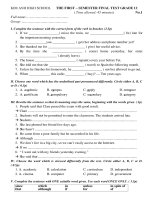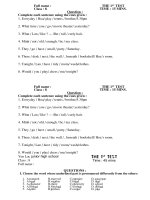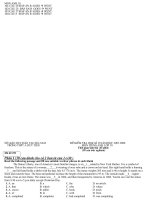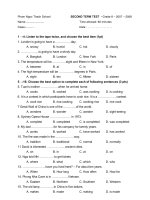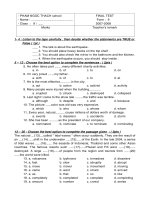marketing - questions for final test prepared
Bạn đang xem bản rút gọn của tài liệu. Xem và tải ngay bản đầy đủ của tài liệu tại đây (279.2 KB, 3 trang )
Marketing is an organizational function & a set of processes
for creating, communicating, and delivering value to customers
& for managing customer relationships in ways that benefit the
organization & its stakeholders.
Identify & explain the stages in the strategic
marketing process
The process is divided into three phases:
Planning phase: Step 1: situation (SWOT) analysis
(identify industry trends, analyze competitors, assess own
company, research present and prospective customer)
Step 2: Market-product focus and goal
setting (set market and product goals, select target
markets, find points of difference, position the product)
Step 3: Marketing program (develop
the program’s marketing mix, develop the budget, by
estimating revenues, expenses, and profits)
Implementation phase (obtain resources, design
marketing organization, develop schedules, execute
marketing program)
Evaluation phase (compare results with plans to identify
deviations, act to correct negative deviations; exploit
positive ones)
What are secondary data & primary data?
(advantages vs. disadvantages)
Secondary data are facts and figures that have already
been recorded before the project at hand. Internal
secondary data come from within the organization, such
as sales reports and customer comments. The most widely
used external secondary data are reports from government
studies on characteristics of the country’s population,
manufacturers, and retailers. Primary data are facts and
figures that are newly collected for the project and are
obtained by either observing or questioning people.
Secondary: (advantages) the tremendous time savings
and low cost such as free or inexpensive Census reports;
(disadvantages) data that may be out of date, and
definitions or categories that may not be appropriate for
the company’s project.
Primary: (advantages) being more specific to the
problem being studied; (disadvantages) far more costly
and time consuming to collect than secondary data.
Marketing creates utility, the benefits or customer value
received by users of the product.
Form utility: the production or alteration of a good or service.
Place utility: having a product available where needed.
Time utility: having a product available when needed.
Possession utility: making an item easy to purchase so
consumers can use it.
Marketing research is the process of defining a marketing
problem & opportunity, systematically collecting & analyzing
information, & recommending actions.
Five-step marketing research approach leading to
marketing actions (1) define the problem; (2) develop
the research plan; (3) collect relevant data; (4) develop
findings; and (5) take marketing actions.
The stages in the consumer decision process (5 stages)
Problem recognition is perceiving a difference between a
person’s ideal and actual situation big enough to trigger a
decision.
Information search involves remembering previous
purchase experiences (internal search) and external search
behavior such as seeking information from other sources.
Alternative evaluation clarifies the problem for the
consumer by (a) suggesting the evaluative criteria to use for the
purchase, (b) yielding brand names that might meet the criteria,
and (c) developing consumer value perceptions.
The purchase decision involves the choice of an
alternative, including from whom to buy and when to buy.
Post purchase behavior involves the comparison of the
chosen alternative with a consumer’s expectations, which leads
to satisfaction or dissatisfaction and subsequent purchase
behavior.
Influences on the consumer purchase decision process
Marketing mix influences (4Ps)
Psychological influences (motivation, personality,
perception, learning, values, beliefs and attitudes, lifestyle)
Sociocultural influences (personal influence, reference
groups, family, social class, culture and subculture)
Situational influences (purchase task, social
surroundings, physical surroundings, temporal effects,
antecedent states)
How stages of the PLC relate to a firm’s marketing
objectives & marketing mix actions
Briefly describe the product life cycle.
The concept of the product life cycle describes the stages
a new product goes through in the marketplace:
introduction, growth, maturity, and decline.
The introduction stage occurs when a product is first
introduced to its intended target market. Sales grow
slowly, and profit is minimal as the result of large
investment costs in product development. The marketing
objective is to create consumer awareness and stimulate
trial. Company spends heavily on advertising and
promotion to stimulate primary demand. Distributions are
limited and the number of variations of the product is
restricted to ensure the control of product quality. Pricing
can be either high or low, depends on using skimming
strategy or penetration strategy.
The growth stage is characterized by rapid increases
in sales. The result of more competitors and more
aggressive pricing is that profit usually peaks during this
stage. Advertising focuses on stimulate selective demand,
stresses the differentiation. It’s important to gain as much
distribution as possible.
Maturity stage is characterized by a slowing of total
industry sales or product class revenue. Marginal
competitors begin to leave the market. Sales increase at a
decreasing rate in the maturity stage as fewer new buyers
enter the market. Profit declines because there is fierce
price competition among many sellers and the cost of
gaining new buyers at this stage increases. Marketing
objective is to hold market share through further product
differentiation and finding new buyers. The major
consideration is to reduce overall marketing cost by
improving promotional and distribution efficiency.
Decline stage occurs when sales begin to drop mostly
because of environmental changes (technological
innovation). Products tend to consume a disproportionate
share of management time and financial resources relative
to their potential future worth. Product deletion is the
most drastic strategy. Harvesting is when a company
retains the product but reduces marketing costs. The
product continues to be offered, but salespeople do not
allocate time in selling nor are advertising dollars spent.
The purpose is to maintain the ability to meet customer
requests.
Some important aspects of PLC are their length, the
shape of the sales curve, how they vary by product classes and
forms, and the rate at which consumers adopt products.
Ways to segment consumer markets
Customer characteristics
Geographic (region, city size, density)
Demographic (gender, age, race, household size,
marital status, income, education, occupation)
Psychographic (personality, values, & lifestyles)
Buying situation
Benefits sought (quality, service, warranty)
Usage/patronage (usage rate – heavy, light, & nonusers)
A product is a good, service, or idea consisting of a bundle of
tangible & intangible attributes that satisfies consumers & is
received in exchange for money or some other unit of value.
What is a brand? Branding strategy?
A brand name is any word, device (design, sound, shape,
or color) or combination of these used to distinguish a
seller’s goods or services.
Branding is a marketing decision by an organization to
use a name phrase, design, or symbols, or combination of
these to identify its products and and distinguish them
from those of competitors.
Branding strategies: multiproduct branding,
multibranding, private branding, and mixed branding.
What are the three demand factors besides the
product’s price or factors that determine consumers’
willingness and ability to pay for goods and services?
- Consumer tastes: demographics, culture, &technology.
- Price and availability of substitutes or similar products.
- Consumer income
The relationships between marketing channels,
logistics, & supply chain management
A marketing channel relies on logistics to make products
available to consumers and industrial users. Logistics
involves those activities that focus on getting the right
amount of the right products to the right place at the right
time at the lowest possible cost. The performance of these
activities is logistics management – the practice of
organizing the cost-effective flow of raw materials, in-
process inventory, finished goods, and related
information from point of origin to point of consumption
to satisfy customer requirements.
What are logistics costs? Include transportation,
materials handling & warehousing, order processing,
inventory, & stockouts.
Key logistics functions in a supply chain:
Transportation, Warehousing & materials handling, Order
processing, & Inventory management
What are functions performed by intermediaries?
Transactional, logistical and facilitating function
What are the types of vertical marketing systems?
VMS are professionally managed and centrally
coordinated marketing channels designed to achieve
channel economies and maximum marketing impact.
There are 3 major types of VMS: corporate, contractual,
and administered. A corporate VMS combines successive
stages of production and distribution under a single
ownership. A contractual VMS exists when independent
production and distribution firms integrate their efforts on
a contractual basis to obtain greater functional economies
and marketing impact than they could achieve alone. The
contractual VMS has three variations, including
wholesaler-sponsored voluntary chains, franchise
program, and retailer-sponsored cooperatives. Franchise
program involves manufacturer-sponsored retail franchise
system, manufacturer-sponsored wholesale franchise
system, service-sponsored retail franchise system, and
service-sponsored franchise system. An administered
VMS achieves coordination at successive stages of
production and distribution by the size and influence of
one channel member rather than through ownership.
What are components of the communication process?
A source, a message, a channel of communication, a
receiver, and the processes of encoding and decoding.
What are elements of the promotional mix?
(definitions + tools)
Advertising: an paid form of nonpersonal
communication about an organization, good, service, or
idea by an identified sponsor (magazines, newspapers,
radio, TV, internet)
Personal selling: the two-way flow of
communication between a buyer and seller, designed to
influence a person’s or group’s purchase decision (face-
to-face communication between the sender and receiver)
Public relations is a form of communication
management that seeks to influence the feelings,
opinions, or beliefs held by customers, prospective
customers, stockholders, suppliers, employees, and other
public about a company and its products or services (
special events, lobbying efforts, annual reports, press
conferences, and images management)
Sales promotion: a short-term inducement of value
offered to arouse interest in buying a good or service
(coupons, rebates, samples, and sweepstakes)
Direct marketing: uses direct communication with
consumers to generate a response in the form of an order,
a request for further information, or a visit to a retail
outlet (direct mail, catalogs, telephone solicitations, direct
response advertising on TV, radio and in print, and online
marketing)
What are methods used to set the promotional
budget?
Percentage of Sales (funds are allocated to promotion
as a percentage of past or anticipated sales, in terms of
either dollars or units sold)
Competitive parity (matching the competitor’s
absolute level of spending or the proportion per point of
market share)
All you can afford (money is allocated to promotion
only after all other budget items are covered)
Objective and task (the company determines its
promotion objectives, outlines the tasks to accomplish
these objectives, and determines the promotion cost of
performing these tasks)
How does competitive product advertising differ from
competitive institutional advertising?
The advertising that promotes a specific brand’s
features and benefits is competitive. The objective of
these messages is to persuade the target market to select
the firm’s brand rather than that of a competitor.
Competitive institutional advertisements promote the
advantages of one product class over another and are used
in markets where different product classes compete for
the same buyers.
Please describe the channel strategies?
A manufacturer uses a push strategy directing the
promotional mix to channel members to gain their
cooperation in ordering and stocking the product. In this
approach, personal selling and sales promotion play
major roles. Salespeople call on wholesalers to encourage
orders and provide sales assistance. Sales promotions,
such as case discount allowances, are offered to stimulate
demand. By pushing the product through the channel, the
goal is to get channel members to push it to their
customers.
A manufacturer uses a pull strategy by directing its
promotional mix at ultimate consumers to encourage
them to ask the retailer for a product. Seeing demand
from ultimate consumes, retailers order the product from
wholesalers and thus the item is pulled through the
intermediaries.
